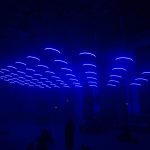Over the last 20 years, advances in computer technology have benefited the entertainment industry. In particular, CAD programs have altered—for the better—how designers execute their ideas. But the benefits of digitizing workflows have changed more than just how we approach design. As a result, there’s never been a more exciting time for our industry. And as the growing availability of mature software tools continues to improve our design thinking, idea communication and the installation and execution of design concepts, we’ll continue to benefit by doing it more efficiently and accurately than ever before. When I reflect on this evolution, the journey has been remarkable. I’d like to share my own journey and how I arrived to this point in time today where we finally have at our fingertips the right tools for the job.
 From IFA to Nemetschek Vectorworks
From IFA to Nemetschek Vectorworks
One of my first experiences in creating plug-in software for the entertainment industry came when I worked for the Facilities Planning group at Imero Fiorentino Associates (IFA) in New York City. I wrote several routines for our internal AV consulting staff to help draw AV and networking diagrams. We were board-drafting back then and, as an assistant, I hand-drafted numerous?I/O diagrams. I became familiar with the ?revision process that consultants follow; each?time a change was made by one of the ?designers, all of the connector lines were at risk of being affected. This often required so many changes that it was less work to redraft the whole diagram rather than fix the parts that changed.
At the time, there was a Mac+ computer in the office that was loaded with Diehl Graphsoft’s MiniCAD+ program. Using this CAD software and the MiniPascal scripting language that came with it, I wrote a routine that took lines from I/O diagrams and redrew them so that there were no crossovers. This was one of the things I found so attractive about computer drafting and design. With this routine, I could make revisions to the diagrams in near-real time.
I used the software to automate some of the tedious revisions that were required in the course of various jobs with Sony, Sheraton Hotels and CNN, as well as in numerous corporate boardrooms. Later, I made a routine called RackMaster for doing equipment rack elevations and also routines for doing the patch and jack panels. In retrospect, this experience was the perfect preparation for my next job when I came to work for Nemetschek Vectorworks, Inc. In 1995, I created the Theatrical Lighting Toolkit for MiniCAD Vectorworks 8.5. This was the predecessor to Vectorworks Spotlight software, which would eventually become the industry standard in the entertainment lighting and event planning world.
 The Right Combination of Tools
The Right Combination of Tools
The Vectorworks Spotlight program became the standard because it provided the right tools for the job of the lighting and scenic designer in a form that was natural and intuitive, and that got the job done far better than hand-drafting. Over the years, many Spotlight users have ?created customized objects and plug-ins to solve specific needs of related entertainment design professions, which has resulted in ?integrating functionality for event planning, video projection and audio layout.
As we head into this year’s InfoComm, I am delighted to tell you about one of these third-party innovations for the industry called connectCAD. Developed by longtime broadcast and AV industry professional Conrad Preen, connectCAD is a software add-on to the Vectorworks platform for designing broadcast, AV, lighting, IT cabling and other connected systems. It solves the problem of keeping track of large numbers of cables or other interconnected systems in a complex ?installation.
Thank goodness the industry doesn’t have to make do with RackMaster! Rather, Conrad Preen has taken this concept to the next level. For example, after entering the design information using a simple form-like interface, connectCAD generates schematics, details and elevations of the design by means of the Vectorworks program’s integrated database, which drives the whole process. This means that what once was an onerous task, the design now practically updates itself as you edit various components.
The system is tightly integrated with the Vectorworks program’s standard CAD software functionality. This lets users import plan and system information from other team members working with other software products and ?display it right in the Vectorworks document. This is a great way to generate virtually any kind of additional documentation for your project, such as plans, elevations and sections, as well as the industry-specific documentation that is made so easily in connectCAD. Of course, ?Vectorworks lets you also create your own ?auxiliary documentation.
In addition, connectCAD takes a practical approach to device libraries. In the real world, manufacturers are constantly improving their products and changing their specifications. As a result, software developers typically have a difficult time keeping these libraries current. However, with connectCAD, keeping your own particular subset of devices up to date is quite simple. Devices such as mixers and switchers are represented schematically and identified with as much detail as needed by entering the desired information into a form-like interface. Once a particular component is defined, you use instances of the device in the active document and import these into all your other ?projects. Plus, connectCAD saves the device as a symbol in the document resources. You never have to draw the same thing more than once. And, you can easily grab and update previously defined devices from other projects. This is done with the Vectorworks Resource Browser, a tool in the program that lets you create, apply and manage resources in a file, as well as access frequently used resources in other files.
When manufacturers update their product line and you want to add their new equipment to the system, you duplicate the earlier version of the device in the library and edit the database with the new product name, number and other new specifications like the number of connections. Then, the new device is ready to use. Since devices in the project file are groups and not symbols, updates to the symbols do not affect previous projects. In practice, this is easier and takes less time than downloading the new manufacturer library, adding it to the system and locating the new gear in the list. Drawing a line with the connection tool between two devices automates the cabling and numbering. The automated cable numbering can be adjusted according to your preferences.
When used in conjunction with the Vectorworks Spotlight program’s internal features, such as the new Speaker and Line Array objects, as well as the Video, Projector and Projection Screen objects and other features with which connectCAD integrates, the platform is a complete planning and documentation system that is tailor-made for this industry. Watching such capabilities and interconnectivities evolve over the past decades has been a delightful benefit of my career. I can’t wait to see what future generations will bring to the table.
Frank Brault, with Nemetschek Vectorworks, ?has more than 30 years of experience in lighting design, software development and training.


